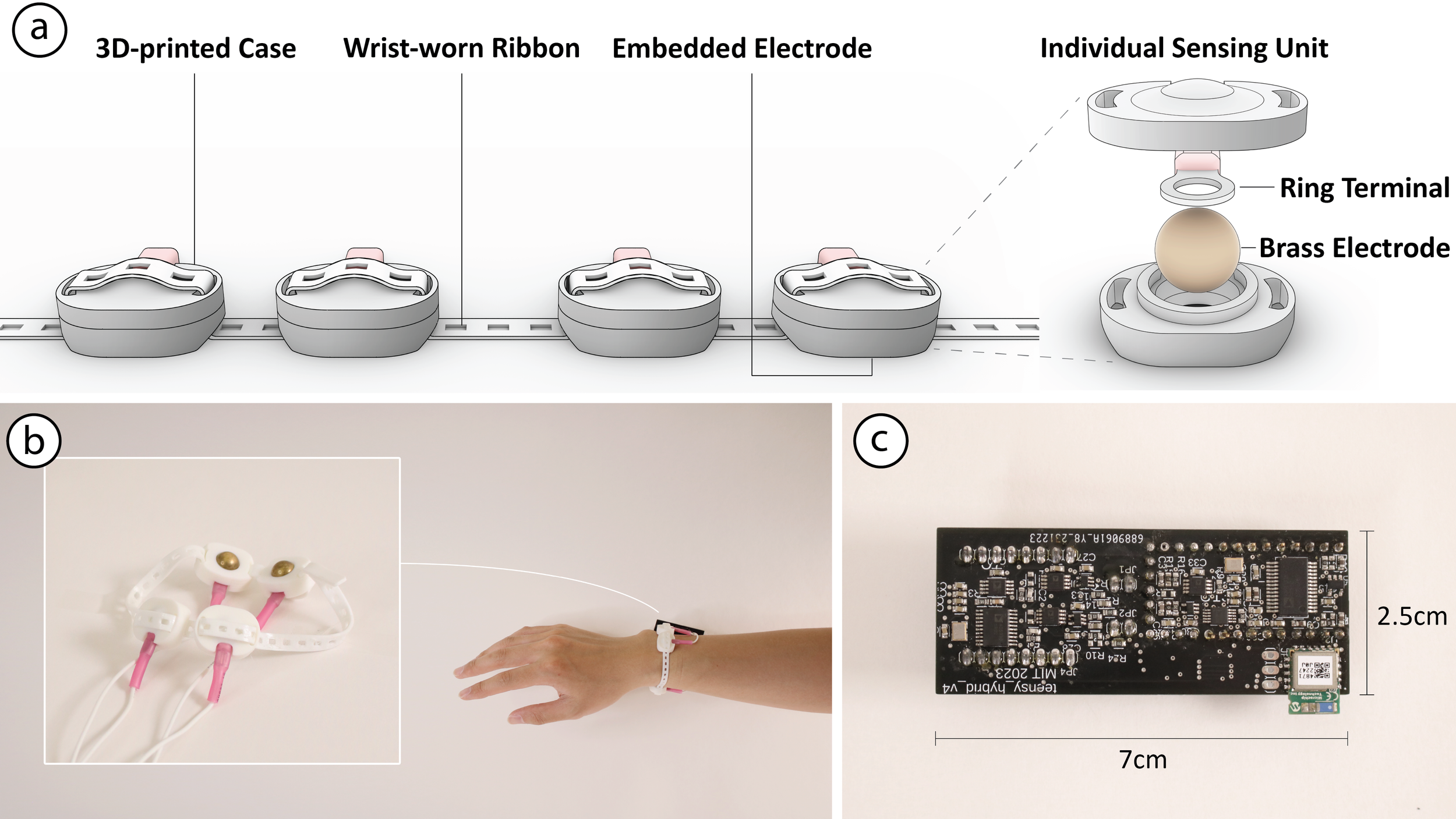EI-Lite: Towards Lightweight Electrical Impedance Sensing for Micro-gesture
Junyi Zhu, Tianyu Xu, Jiayu Wang, Emily Guan, JaeYoung Moon, Stiven Morvan, D Shin, Andrea Colaço, Stefanie Mueller, Karan Ahuja, Yiyue Luo, Ishan Chatterjee
ACM UIST '2025 Read Paper
Abstract
Micro-gesture recognition enables intuitive and discreet control of devices, offering significant potential for enhancing human-computer interaction (HCI). In this paper, we present EI-Lite, a lightweight wrist-worn electrical impedance sensing device for micro-gesture recognition and continuous pinch force estimation. We elicit an optimal and simplified device architecture through an ablation study on electrode placement with 13 users. Implementing the elicited designs through 3D printing, we then capture data on 15 participants on (1) six common micro-gestures and (2) index finger pinch forces. We develop machine learning models that interpret the impedance signals generated by these micro-gestures.
Our system is capable of accurate recognition of micro-gesture events (96.33% accuracy), as well as continuously estimating the pinch force of the index finger in physical units (Newton), with the mean-squared-error (MSE) of 0.3071 (or mean-force-variance of 0.55 Newtons) over 15 participants. These results highlight our system's potential for applications in various HCI scenarios, such as AR/VR, gaming, and assistive technologies.
Wearable Sensing Wristband
The electrical impedance sensing wrist band consists of a wrist-worn ribbon and 4 individual sensing units. The wrist-worn ribbon (0.6cm x 27cm x 0.05cm) is 3D printed with TPU and lined up with slots (0.2cm x 0.3cm) every 0.3cm. One end of the ribbon has two extruded buttons that can be inserted into the slots to create an adjustable wristband for wrist circumferences ranging from 10 to 22 cm. The 4 individual sensing units each consists of a case, a brass ball, and a ring terminal. The case (1.7cm x 2.2cm x 0.7cm) is 3D printed with PLA and consists of two parts that can be tightly locked with a snap-fit joint after the components are placed within. The case has two slots on both sides for the wrist-worn ribbon to thread through, with just enough flexibility for adjustable positioning of the unit while having enough friction to keep it in place. The brass ball (3/8" diameter) fits tightly inside the case, mechanically connected to the ring terminal, with one third of its height exposed at the bottom to be in contact with the skin, allowing for a point-contact at desired location for each user to optimize accuracy. Finally, the ring terminals are connected to multi-thread wires via the crimping tool to transmit the AC signal from and the resulting voltage response to the sensing board. Overall, the wearable form factor is designed to be lightweight, small, and flexible.
EI-Lite system overview.
(a) The design layout of our wearable electrical impedance sensing wrist band, with 4 individually adjustable electrodes.
(b) The electrodes are placed on top and bottom of the wrist’s distal radioulnar joint in a 2-by-2 setup.
(c) The coupled readout circuit board to serialize electrical impedance readings.
EI-Lite is a lightweight electrical impedance sensing system for
(a) micro-gesture recognition
(b) continuous pinch force estimation
Electrode Location & Ablation Study.
(a) The user study was performed by capturing electrical impedance signals from 2 by 32 electrodes around both proximal carpal row (L1) and distal radioulnar joint (L2) area.
(b) The electrical pairs’ signal effectiveness ranking in red-to-blue color spectrum.
(c) The signal effectiveness heat map around the wrist area in red-to-blue color spectrum.
Synchronized force-sensitive resistor readings and electrical impedance signals for
(a) index finger pinch start
(b) index finger pinch release
(c) middle finger pinch start
(d) middle finger pinch release
(e) swipe right
(f) swipe left



